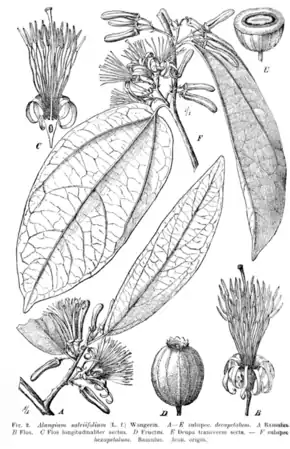Alangiaceae
La famille des Alangiaceae regroupe des plantes dicotylédones. Selon Watson & Dallwitz elle comprend 20 espèces réparties en deux genres :
- Alangium
- Metteniusa
Alangiaceae

| Règne | Plantae |
|---|---|
| Sous-règne | Tracheobionta |
| Division | Magnoliophyta |
| Classe | Magnoliopsida |
| Sous-classe | Rosidae |
| Ordre | Cornales |
Pour la plupart des systèmes taxonomiques elle comprend seulement Alangium.
Ce sont des arbres, des arbustes et parfois des lianes, à latex, des régions tropicales.
La classification phylogénétique APG II (2003)[1] et la classification phylogénétique APG III (2009)[2] incorporent Alangium à la famille Cornaceae.
Liens externes
- (en) Référence Madagascar Catalogue : Alangiaceae
- (en) Référence Flora of Pakistan : Alangiaceae
- (en) Référence DELTA Angio : Alangiaceae
- (fr+en) Référence ITIS : Alangiaceae DC.
- (en) Référence GRIN : famille Alangiaceae DC. (+liste des genres contenant des synonymes)
- Portail de la botanique
- (en) Angiosperm Phylogeny Group, « An update of the Angiosperm Phylogeny Group classification for the orders and families of flowering plants: APG II », Botanical Journal of the Linnean Society, Wiley-Blackwell, Linnean Society of London et OUP, vol. 141, no 4, , p. 399–436 (ISSN 0024-4074 et 1095-8339, DOI 10.1046/J.1095-8339.2003.T01-1-00158.X)
- (en) Angiosperm Phylogeny Group, « An update of the Angiosperm Phylogeny Group classification for the orders and families of flowering plants: APG III », Botanical Journal of the Linnean Society, Wiley-Blackwell, Linnean Society of London et OUP, vol. 161, no 2, , p. 105–121 (ISSN 0024-4074 et 1095-8339, DOI 10.1111/J.1095-8339.2009.00996.X)
Cet article est issu de Wikipedia. Le texte est sous licence Creative Commons - Attribution - Partage dans les Mêmes. Des conditions supplémentaires peuvent s'appliquer aux fichiers multimédias.